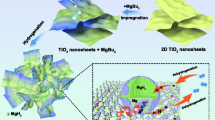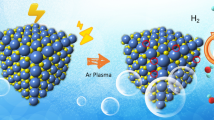Abstract
Vacuum synthesis of molybdenum disulfide (MoS2) using molybdenum trioxide (MoO3) and sulfur powder is presented in this study based on the equilibrium phase diagram of MoO3-S and MoO2-S at 10 Pa. The phase transitions and controlled sulfurization during the process of MoO3 to MoS2 were carried out in the temperature range from 673 to 1073 K, and 2H-MoS2 were obtained by controlling the addition of sulfur powder. It was found that MoO2 is the only detectable intermediate phase via the reactions of sulfur with MoO3 from 673 to 973 K. The experimental findings confirmed that the sulfurization of MoO3 to MoS2 was a consecutive reaction with the intermediate product MoO2, which could be demonstrated by the results of X-ray diffraction (XRD), scanning electron microscopy (SEM) with energy dispersive spectrometer (EDS), Raman spectroscopy and X-ray photoelectron spectroscopy (XPS). With the increases in temperature were promoted the conversion of MoO2 to MoS2, and MoS2 was formed at 1073 K with average lateral dimensions of ~ 1.30 μm. The formation of MoS2 in vacuum was found to obey the chemical vapor transport (CVT) mechanism under the experimental condition, as the phase transition of "MoO3 → MoO2 → MoS2" was confirmed and the morphology evolutions were given in this work.












Similar content being viewed by others
References
Xu M, Liang T, Shi M et al (2013) Graphene-like two-dimensional materials. Chem Rev 113(5):3766–3798. https://doi.org/10.1021/cr300263a
Lee HS, Min SW, Chang YG et al (2012) MoS2 nanosheet phototransistors with thickness-modulated optical energy gap. Nano Lett 12(7):3695–3700. https://doi.org/10.1021/nl301485q
Wang QH, Kalantar-Zadeh K, Kis A et al (2012) Electronics and optoelectronics of two-dimensional transition metal dichalcogenides. Nat Nanotechnol 7(11):699–712. https://doi.org/10.1038/nnano.2012.193
Samaniego-Benitez JE, Mendoza-Cruz R, Bazán-Díaz L et al (2020) Synthesis and structural characterization of MoS2 micropyramids. J Mater Sci 55(26):12203–12213. https://doi.org/10.1007/s10853-020-04878-y
Radisavljevic B, Radenovic A, Brivio J et al (2011) Single-layer MoS2 transistors. Nat Nanotechnol 6(3):147–150. https://doi.org/10.1038/nnano.2010.279
Jing X, Illarionov Y, Yalon E et al (2020) Engineering field effect transistors with 2D semiconducting channels: status and prospects. Adv Funct Mater 30(18):1901971. https://doi.org/10.1002/adfm.201901971
Huo J, Xue Y, Zhang X et al (2018) Hierarchical porous reduced graphene oxide decorated with molybdenum disulfide for high-performance supercapacitors. Electrochim Acta 292:639–645. https://doi.org/10.1016/j.electacta.2018.09.180
Wei Y, Lv Y, Guo B et al (2021) Hierarchical molybdenum disulfide nanosheet arrays stemmed from nickel-cobalt layered double hydroxide/carbon cloth for highly-efficient hydrogen evolution reaction. J Energy Chem 57:587–592. https://doi.org/10.1016/j.jechem.2020.09.024
Ma J, Cai A, Guan X et al (2020) Preparation of ultrathin molybdenum disulfide dispersed on graphene via cobalt doping: a bifunctional catalyst for hydrogen and oxygen evolution reaction[J]. Int J Hydrogen Energ 45(16):9583–9591. https://doi.org/10.1016/j.ijhydene.2020.01.176
Tao Y, Lao YH, Yi K et al (2021) Noble metal-molybdenum disulfide nanohybrids as dual fluorometric and colorimetric sensor for hepatitis B virus DNA detection. Talanta 234:122675. https://doi.org/10.1016/j.talanta.2021.122675
Martínez-Periñán E, García-Mendiola T, Enebral-Romero E et al (2021) A MoS2 platform and thionine-carbon nanodots for sensitive and selective detection of pathogens. Biosens Bioelectron 189:113375. https://doi.org/10.1016/j.bios.2021.113375
Zheng X, Calò A, Cao T et al (2020) Spatial defects nanoengineering for bipolar conductivity in MoS2. Nat Commun 11(1):1–12. https://doi.org/10.1038/s41467-020-17241-1
Qi F, Li P, Chen Y et al (2015) Effect of hydrogen on the growth of MoS2 thin layers by thermal decomposition method. Vacuum 119:204–208. https://doi.org/10.1016/j.vacuum.2015.05.023
Fareza AR, Nugroho FAA, Fauzia V (2021) Facile synthesis of 1T-MOS2 nanoflowers using hydrothermal method. Mater Sci 1028:173–178. https://doi.org/10.4028/www.scientific.net/MSF.1028.173
Huang KJ, Zhang JZ, Shi GW et al (2014) Hydrothermal synthesis of molybdenum disulfide nanosheets as supercapacitors electrode material. Electrochim Acta 132:397–403. https://doi.org/10.1016/j.electacta.2014.04.007
Li B, Ju Q, Hong W et al (2021) Edge defect-assisted synthesis of chemical vapor deposited bilayer molybdenum disulfide. Ceram Int 47(21):30106–30112. https://doi.org/10.1016/j.ceramint.2021.07.188
Singh A, Moun M, Singh R (2019) Effect of different precursors on CVD growth of molybdenum disulfide. J Alloy Compd 782:772–779. https://doi.org/10.1016/j.jallcom.2018.12.230
Nath M, Govindaraj A, Rao CNR (2001) Simple synthesis of MoS2 and WS2 nanotubes. Adv Mater 13(4):283–286. https://doi.org/10.1002/1521-4095(200102)13:43.0.CO;2-H
Xiang M, Liu H, Huang C et al (2020) Mo doping assisting the CVD synthesis of size-controlled, uniformly distributed Single-layer MoS2 on rutile TiO2 (110). ACS Appl Mater Inter 12(30):34378–34387. https://doi.org/10.1021/acsami.0c07997
Guan R, Duan J, Yuan A et al (2021) Chemical vapor deposition of clean and pure MoS2 crystals by the inhibition of MoO3−x intermediates. CrystEngComm 23(1):146–152. https://doi.org/10.1039/d0ce01354d
Pondick JV, Woods JM, Xing J et al (2018) Stepwise sulfurization from MoO3 to MoS2 via chemical vapor deposition. ACS Appl Nano Mater 1(10):5655–5661. https://doi.org/10.1021/acsanm.8b01266
Weber T, Muijsers JC, Niemantsverdriet JW (1995) Structure of amorphous MoS3. J Phys Chem 99(22):9194–9200. https://doi.org/10.1021/j100022a037
Brito JL, Severino F, Delgado NN et al (1998) HDS activity of carbon-supported Ni–Mo catalysts derived from thiomolybdate complexes. Appl Catal A 173(2):193–199. https://doi.org/10.1016/S0926-860X(98)00179-3
Hu KH, Hu XG, Sun XJ (2010) Morphological effect of MoS2 nanoparticles on catalytic oxidation and vacuum lubrication. Appl Surf Sci 256(8):2517–2523. https://doi.org/10.1016/j.apsusc.2009.10.098
Dieterle M, Weinberg G, Mestl G (2002) Raman spectroscopy of molybdenum oxides Part I. Structural characterization of oxygen defects in MoO3−x by DR UV/VIS, Raman spectroscopy and X-ray diffraction. Phys Chem Chem Phys 4(5):812–821. https://doi.org/10.1039/b107012f
Raza SH, Afzal N, Rafique M et al (2020) Structural and morphological properties of annealed MoO3 films on different substrates. Surf Rev Lett 27(05):1950150. https://doi.org/10.1142/s0218625x19501506
Jian J, Chang H, Xu T (2019) Structure and properties of single-layer MoS2 for nano-photoelectric devices. Materials 12(2):198. https://doi.org/10.3390/ma12020198
Mohammadbeigi M, Jamilpanah L, Rahmati B et al (2019) Sulfurization of planar MoO3 optical crystals: enhanced Raman response and surface porosity. Mater Res Bull 118:110527. https://doi.org/10.1016/j.materresbull.2019.110527
Bell RE, Herfert RE (1957) Preparation and characterization of a new crystalline form of molybdenum disulfide. J Am Chem Soc 79(13):3351–3354. https://doi.org/10.1021/ja01570a012
Kim H, Park T, Leem M et al (2021) Sulfidation characteristics of amorphous nonstoichiometric Mo-oxides for MoS2 synthesis. Appl Surf Sci 535:147684. https://doi.org/10.1016/j.apsusc.2020.147684
Wang W, Yao Q, Ma J et al (2020) Engineering MoS2 nanostructures from various MoO3 precursors towards hydrogen evolution reaction. CrystEngComm 22(12):2258–2267. https://doi.org/10.1039/C9CE01904A
Ling L, Wang C, Zhang K et al (2016) Controlled growth of MoS2 nanopetals and their hydrogen evolution performance. RSC Adv 6(22):18483–18489. https://doi.org/10.1039/c5ra24908b
Yaws CL (2015) The Yaws handbook of vapor pressure: Antoine coefficients. Gulf Professional Publishing
Dresselhaus MS, Jorio A, Hofmann M et al (2010) Perspectives on carbon nanotubes and graphene Raman spectroscopy. Nano Lett 10(3):751–758. https://doi.org/10.1021/nl904286r
Li J, Yin J, Li X et al (2016) Chemical vapor deposition of ultra-thin molybdenum dioxide nanosheets. Mater Lett 174:188–191. https://doi.org/10.1016/j.matlet.2016.03.081
Wang HW, Skeldon P, Thompson GE (1997) XPS studies of MoS2 formation from ammonium tetrathiomolybdate solutions. Surf Coat Tech 91(3):200–207. https://doi.org/10.1016/S0257-8972(96)03186-6
Wang X, Cormier CR, Khosravi A et al (2020) In situ exfoliated 2D molybdenum disulfide analyzed by XPS. Surf Sci Spectra 27(1):014019. https://doi.org/10.1063/1.5138923
Wei J, He P, Wu J et al (2022) Conversion of 2H-MoS2 to 1T-MoS2 via lithium ion doping: Effective removal of elemental mercury. Chem Eng J 428:131014. https://doi.org/10.1016/j.cej.2021.131014
Wang B, Zhang Y, Zhang J et al (2017) (2017) Facile synthesis of a MoS2 and functionalized graphene heterostructure for enhanced lithium-storage performance. ACS Appl Mater Inter 9(15):12907–12913. https://doi.org/10.1021/acsami.7b00248
Klosse K, Ullersma P (1973) Convection in a chemical vapor transport process. J Cryst Growth 18(2):167–174. https://doi.org/10.1016/0022-0248(73)90195-4
Acknowledgements
This research work is financially supported by Yunnan Provincial Scientists’ Workshop and Top Young Talents of Yunnan Province Ten Thousand Talents Plan (109720190004). We also greatly appreciate Professor Kongzhai Li who offered detection of Raman spectra.
Author information
Authors and Affiliations
Corresponding author
Additional information
Handling Editor: N. Ravishankar.
Publisher's Note
Springer Nature remains neutral with regard to jurisdictional claims in published maps and institutional affiliations.
Rights and permissions
Springer Nature or its licensor holds exclusive rights to this article under a publishing agreement with the author(s) or other rightsholder(s); author self-archiving of the accepted manuscript version of this article is solely governed by the terms of such publishing agreement and applicable law.
About this article
Cite this article
Chen, Y., Lu, C., Wang, F. et al. Phase transitions and controlled sulfurization of molybdenum oxides in vacuum. J Mater Sci 57, 16569–16580 (2022). https://doi.org/10.1007/s10853-022-07669-9
Received:
Accepted:
Published:
Issue Date:
DOI: https://doi.org/10.1007/s10853-022-07669-9




